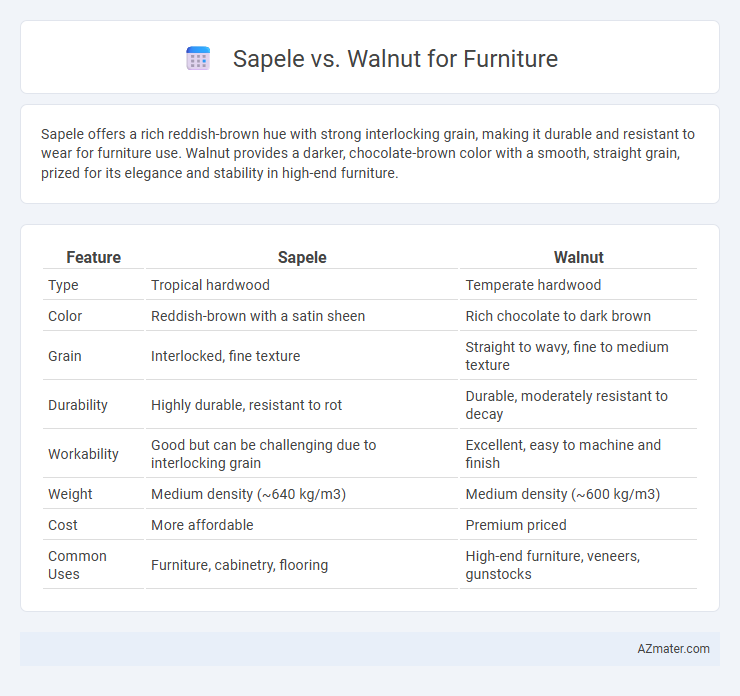Sapele offers a rich reddish-brown hue with strong interlocking grain, making it durable and resistant to wear for furniture use. Walnut provides a darker, chocolate-brown color with a smooth, straight grain, prized for its elegance and stability in high-end furniture.
Table of Comparison
| Feature | Sapele | Walnut |
|---|---|---|
| Type | Tropical hardwood | Temperate hardwood |
| Color | Reddish-brown with a satin sheen | Rich chocolate to dark brown |
| Grain | Interlocked, fine texture | Straight to wavy, fine to medium texture |
| Durability | Highly durable, resistant to rot | Durable, moderately resistant to decay |
| Workability | Good but can be challenging due to interlocking grain | Excellent, easy to machine and finish |
| Weight | Medium density (~640 kg/m3) | Medium density (~600 kg/m3) |
| Cost | More affordable | Premium priced |
| Common Uses | Furniture, cabinetry, flooring | High-end furniture, veneers, gunstocks |
Introduction: Sapele vs Walnut for Furniture
Sapele and walnut are two popular hardwood choices for furniture, each prized for its unique grain patterns and durability. Sapele features a rich reddish-brown hue with a distinctive interlocking grain, offering excellent resistance to wear and moisture. Walnut, known for its deep chocolate tones and fine straight grain, provides superior workability and a luxurious finish ideal for high-end furniture pieces.
Overview of Sapele Wood
Sapele wood, a species native to tropical Africa, is highly regarded in furniture making for its rich reddish-brown color and elegant grain patterns resembling mahogany. This hardwood boasts excellent durability, resistance to rot, and natural stability, making it ideal for high-quality, long-lasting furniture pieces. Its workability combines well with a polished finish, providing a smooth surface that enhances the wood's natural lustrous sheen.
Overview of Walnut Wood
Walnut wood is highly prized for furniture due to its rich, dark brown color and attractive grain patterns that range from straight to wavy, giving each piece a distinctive appearance. Known for its durability and strength, walnut offers excellent resistance to warping, making it ideal for fine furniture, cabinetry, and veneers. Its natural luster and ease of finishing enhance the aesthetic appeal, positioning walnut as a premium wood choice compared to alternatives like sapele.
Appearance and Grain Patterns
Sapele features a rich reddish-brown hue with a shimmering, interlocked grain pattern that creates a striking, almost striped or wavy effect ideal for elegant furniture design. Walnut boasts a deep chocolate to purplish-brown color with a more uniform, straight grain and occasional curly or burl figure that adds warmth and sophistication to crafted pieces. The contrasting grain complexities make Sapele excellent for bold, decorative accents, while Walnut excels in classic, timeless furniture aesthetics.
Durability and Hardness Comparison
Sapele wood has a Janka hardness rating of around 1,410, making it moderately hard and durable, suitable for furniture that can withstand everyday use. Walnut, with a Janka hardness of approximately 1,010, is softer but prized for its rich color and workability, often chosen for decorative furniture pieces. While Sapele offers greater resistance to dents and scratches, Walnut provides a balance of moderate durability and aesthetic appeal for high-end furniture applications.
Workability and Machinability
Sapele offers excellent workability with its fine, interlocked grain, making it easier to shape and sand compared to walnut, which can sometimes pose challenges due to its open grain and occasional irregularities. Walnut has moderate machinability, requiring sharp tools and slower feed rates to prevent tear-out, while sapele's dense yet stable nature allows for smoother cutting and milling processes. Both woods respond well to finishing, but sapele's harder texture demands more careful tool maintenance during machining to achieve a high-quality surface.
Cost and Availability
Sapele wood typically offers a more affordable option compared to walnut, with prices about 30-40% lower due to its wider availability, especially in West Africa. Walnut is considered a premium hardwood, often costing significantly more because it is sourced mainly from North America and Europe, where sustainable harvesting limits its supply. The abundant availability of Sapele makes it a popular choice for budget-conscious furniture makers without compromising on aesthetic quality.
Environmental Impact and Sustainability
Sapele and Walnut differ significantly in environmental impact and sustainability, with Sapele being a fast-growing hardwood native to West Africa, often sourced from managed plantations that support reforestation efforts. Walnut, predominantly grown in North America, has slower growth rates, requiring longer harvest cycles that can challenge sustainable supply if not responsibly managed. Choosing Sapele supports reduced deforestation and promotes biodiversity, while Walnut furniture demands careful consideration of certified sustainable harvesting to minimize ecological footprint.
Best Uses in Furniture Design
Sapele wood excels in furniture design requiring durability and intricate detailing, making it ideal for cabinetry, veneers, and high-end joinery due to its medium hardness and attractive interlocked grain. Walnut is preferred for luxury furniture pieces, emphasizing rich, dark tones and smooth textures, perfect for statement chairs, tables, and carved elements that highlight aesthetic appeal. Both woods offer stability and workability, with Sapele suited for practical, sturdy designs and Walnut favored in fine, decorative applications.
Conclusion: Which Wood is Better for Furniture?
Sapele offers a rich reddish-brown color with excellent durability and resistance to wear, making it ideal for high-traffic furniture pieces. Walnut, prized for its deep chocolate tones and fine grain, provides superior workability and an elegant finish favored in luxury furniture. For durable, affordable options, Sapele is preferable, whereas Walnut is better suited for premium, aesthetically refined furniture.

Infographic: Sapele vs Walnut for Furniture
 azmater.com
azmater.com